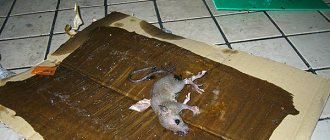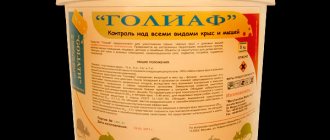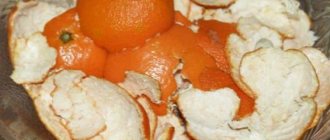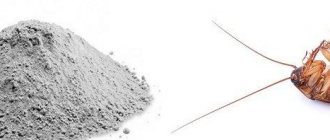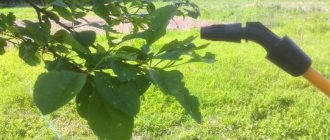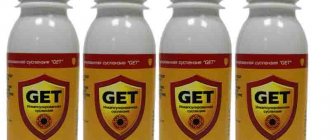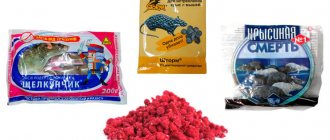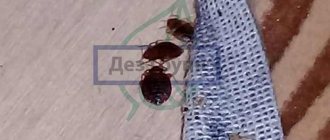If you have decided to choose a rat repellent yourself, then you may have already appreciated how difficult this task can be for an unprepared person. It is even more difficult if you are looking for a remedy that will be both effective, safe and relatively inexpensive.
There are many varieties of rat poisons available for sale, and it is easy to get confused. Moreover, you are offered to poison some unfortunate rodent, kill it with traps, frighten it with a repeller, or catch it on a piece of cardboard coated with special glue for rats and mice.
And at first glance, each of these options seems to be good in its own way, but it is not clear which one to prefer. It is all the more difficult to choose an effective remedy for rats based on the promises of sellers, because it is often difficult to understand where the truth ends and where advertising begins.
Well, then we will put all this chaos in order and choose from the currently available means used against rats and mice those that are best used at home...
Types of rodent control products and why rat poisons are so popular today
First, let's classify the remedies for rats and mice according to their mode of action.
All of them can be divided into the following groups:
- Poisons, including those prepared according to folk recipes. In terms of ease of use and effectiveness, it is poisons that lead the way: some of them are so effective that it is enough to spread the drug once in suitable places to forget about rodents for a long time. We will talk about the important nuances of choosing and using such funds a little lower;
- Traps (lethal and live traps, including glue traps). The main disadvantage of traps of various designs is the need to load them, check them and remove the corpses of killed rats. It is even more troublesome to work with live traps and glue traps - after all, rats and mice are caught alive in them, and the rodent fighter then needs to either take the sin on his soul by killing the animal with his own hands, or, say, take the prey out of town and release it to nature;
- Repellents (ultrasonic repellers and chemicals, including those based on folk recipes) are also quite popular and sometimes actually give good results. However, the main problem here is that not all rodents always try to leave the territory protected by a sound or odorous repellent, and sometimes they even get used to it.
On a note
Generally speaking, poisonous agents also include the so-called fumigants - poisonous gases. However, they are completely unsuitable for use at home; they are used only by professional rodent exterminators at industrial sites.
We are also not considering rat-catching cats here, since if you need a remedy against rats and mice, it means that neither you nor your neighbors have such a cat. And purchasing an animal only as a “means” is unethical.
As for remedies for mice and rats in the form of poisons, today there are many drugs on sale with different active ingredients:
- Preparations based on blood anticoagulants are the most modern, most effective and most often used;
- Krysid - still used, including at home, but losing competition to blood anticoagulants and therefore rapidly losing its relevance;
- Products based on phosphides of certain metals are now prohibited for use at home, but are sometimes used in various enterprises. When interacting with water (for example, air moisture), they release extremely toxic phosphine gas;
- Completely prohibited today are preparations based on arsenic (arsenites and arsenates), strychnine, cyanides and some other toxic substances;
- And finally, folk remedies that poison rats (usually made from natural raw materials).
And since poisons are so popular and effective, let us dwell in more detail on those of them that are acceptable for use in everyday life and really allow you to get rid of rodents quickly and without much hassle.
Rat repellents based on blood anticoagulants
The main advantage of these products is their high efficiency. This is largely due to the fact that blood anticoagulants do not act very quickly: the same, for example, strychnine or cyanide, kill a rat much faster, and in smaller doses. However, it is precisely the “slowness” of action that is the strong point of drugs based on blood anticoagulants.
Look: if a rat tries just a little bait with strychnine (or arsenic), it quickly feels the symptoms of poisoning, but does not die. And these animals, because of their innate caution, try everything new bit by bit. So, will a rat that was poisoned but survives eat the same bait next time? As practice shows, with a high probability it will not, and it will let its relatives know that this remedy cannot be tried.
But if a rat eats a small amount of a blood anticoagulant, it will not feel anything at all for several days. Such drugs do not cause any symptoms in sublethal doses. The next day, the animal “with a light heart” and good health will eat this poison again, and then again.
Blood anticoagulants have pronounced cumulative properties (accumulate in the body), and when the amount of poison reaches a critical level, the rat’s blood practically stops clotting. This is fatal - internal bleeding begins, which kills the pest.
It is precisely due to the fact that rats are not afraid of anticoagulant-based drugs that these drugs are more effective than most other poisons. In addition, rodents practically do not develop resistance to them. Today, these products are considered the most preferable for home use, and for use in agriculture and industrial facilities.
Blood anticoagulants are divided into two generations. The first includes substances that the animal must eat several times to be poisoned (their lethal dose is too large and is not absorbed in the rodent’s digestive tract after a single meal of the poisoned bait). Second-generation blood anticoagulants work effectively, even if the animal has eaten the poison only once - their lethal dose is smaller, and all of it can be absorbed at once.
First generation anticoagulants include:
- Warfarin, or zoocoumarin (products Zookoumarin, Zookoumarin Neo, Zoopasta);
- Difenacin (preparations Hedgehog, MEF, Ratindan, Rotendan, MEF, Hedgehog);
- Triphenacin (poisons Ethylphenacin paste, Gelcin);
- Chlorphasinone (ratidion-HF briquettes);
- Coumatetralyl (Rakumin powder).
It is also useful to read: Rat Death Poison No. 1: instructions for use and reviews of the product
Second generation anticoagulants:
- Flocumafen (poisons Storm, Goliath);
- Brodifacoum (Alt, Krysin, Boycott, Mortorat, Rat Death No. 1, Varat, Nutcracker, Cyclone, Efa-Shock, Kilmays products);
- Isoindan (Izocin concentrate for making your own poison);
- Bromadiolone (drugs Rat Death No. 2, Clean House, Efa, Zernotsin, Rattidion, Norat, Blockade);
- Difenacum (poisons Ratol and Tsunami-Extra).
Of all the poisons that prevent blood clotting, flocumafen is considered the most powerful, and the most effective and at the same time affordable product for household use based on it is Storm (manufactured by BASF).
Interestingly, anticoagulant drugs are mostly quite inexpensive. They can be bought on the market for 30-100 rubles, they are sold in small packages (often tens or hundreds of grams) and are almost ideal for use in the home.
Review
“As for me, the best remedy for rats is Zookoumarin. We once poisoned cockroaches several times with different Raptor products, I looked for a drug for rats from the same company, but couldn’t find it, so I had to experiment again. This Zookoumarin is sold in small bags at the market, but you can negotiate with the seller and buy it in bulk. I took it that way, because we have a warehouse and there are a lot of rats. Really helps! Rats eat these pills for their dear soul, after that just go and collect the carcasses. By the way, they die as usual, there is no mummifying effect, although it is written about it on the packaging. If you don’t find it in time and throw it away, they stink mercilessly. But the main thing is that the remedy is effective...”
Oksana, Nizhny Novgorod
Krysid and rules for its use
Rat is a toxic substance whose chemical name is alpha-naphthylthiourea (abbreviated ANTU). Previously, it was especially widely used as a rodenticide due to its very high toxicity to rats and mice.
However, in terms of effectiveness and safety of use, Krysid is noticeably inferior to drugs based on blood anticoagulants. Due to its volatility, people and pets should not be in the room where it is used - the poison can enter the respiratory tract and cause poisoning.
In addition, due to its acute effect, rats and mice quickly develop individuals who recognize it as poison and do not eat it.
On a note
Practice shows that if you do not alternate Krysid with other means, then after 2-3 weeks the rats will stop touching it. In the end, it will help if you try to poison one or two rats with it, but the remedy will most likely not cope with a large number of pests.
In any case, Krysid does not have any advantages over drugs based on blood anticoagulants, but the disadvantages are obvious. Therefore, today there is no point in buying this product for use at home.
Drowning
Another of the easiest ways to kill a caught rat is to drown it. If you catch a pest in a bucket or barrel, you can cover the animal with a thick rag and put a heavy object on top so that the rat does not jump out. Then simply fill the container with water.
But here you will have to try to ensure that the rodent is well pressed to the bottom, because, sensing the approach of death, it can get a surge of strength and try to escape from under the load, so it is recommended to press the rag with a stick and hold it there for several minutes until it choke and die. You can simply pour the dead animal out of the bucket and prepare a trap for subsequent rodent catching.
Preparations based on phosphides
This group includes products based on zinc phosphide, magnesium phosphide and aluminum phosphide, of which the first is zinc phosphide. All of them react with moisture in the air, releasing phosphine, a poisonous gas that kills rats (as well as all other mammals and insects that find themselves in the treated area).
Phosphides are also dangerous for humans and all domestic animals, and therefore their use in residential premises is strictly prohibited. They are used only in industrial enterprises, in workshops from which all workers have previously been removed.
So if you read somewhere that phosphides (or phosphine) are excellent at killing rats, then buying such products for use at home would not be the best idea.
Smoke bombs
Such products are effective and inexpensive. In addition, with the help of smoke bombs you can get rid of not only annoying rodents, but also fungus, mold, various insects that poison life and even ticks. However, such products should also never be used in city apartments.
The active component of these drugs is sulfur. To use a checker, you must first study the instructions for a specific product in detail. After this, you need to remove flowers, food, and animals from the premises being treated. Once ignited, the bomb begins to emit very acrid smoke. It penetrates into all the cracks and corners of the room. Thus, pests are practically smoked out of the house. During the burning of the checker, you need to carefully monitor that a pet does not enter the house or a child runs into it. After treatment, you can forget about many pests for quite a long time. But many note the difficulty of using this method, which is why smoke bombs are at the end of the list in the rating.
Source
Traditional recipes for poisons for rats and mice
Poisons for rodents, prepared according to folk recipes, are significantly inferior to industrial preparations in their effectiveness: in many cases, pests bypass them and do not eat them. However, sometimes such remedies really work, and quite well, and therefore, if you wish, you can try one of them at home or in the country.
The most famous are the following “folk art products”:
- Gypsum in milk - acts by thickening the gypsum in the rat’s intestines, blocking it and developing obstruction. In common parlance, this syndrome is called volvulus. It works poorly, since the animals easily recognize the taste of gypsum even with the first sips of milk;
- Quicklime with sugar - theoretically works due to the heating of lime in the animal’s stomach and corroding its walls. There is no reliable data on the effectiveness of this remedy, but in any case it is difficult to expect that rats or mice will not taste the caustic lime in the mixture and will eat such poisoned sugar;
- Cork shavings, which are mixed with crushed cat food or porridge. In sufficient quantities, swelling in the intestines can also cause obstruction;
- A tincture of chilibuja (emetic nut) added to a liquid bait such as milk or soup. It is very poisonous due to the content of strychnine, but it has a pronounced characteristic odor, similar to garlic, and therefore rats usually know that it is poison.
In general, you shouldn’t place much hope on folk remedies for rats and mice. However, if you wish, you can experiment with them by taking measures in advance to ensure that none of your pets find the bait.
Review
“Once upon a time, plaster of Paris with milk was a really strong remedy; my mother used it to poison rats in my grandmother’s house. They died in batches! But now I installed it at the dacha - it doesn’t help. Either the rats are somehow resistant, or new ones come to replace the dead ones, but they drink the poison and do not disappear. I’ll have to buy some kind of rat pestilence...”
Alena, St. Petersburg
Rat and mouse repellents
It’s worth considering right away that repellents generally work worse than poisons. Even professional devices may not frighten certain “seasoned” rats, and pests do not pay any attention to many traditional repellents.
The most reliable are powerful ultrasonic rat repellers: for example, devices Chiston-2 Pro, Biostrazh (aka Chiston-4), TM-315, WK-0600, Spectrum and some others, which have powerful emitters and specially programmed microcontrollers that change the frequency of ultrasound to exclude addictive effect. Also, devices costing 1,000 rubles or more work more or less effectively - ElectroKot, Tsunami-2 and analogues of the same class, although there are also enough negative reviews about their work.
In any case, remember that in addition to rats, ultrasound can also be heard by pets (cats, dogs, guinea pigs, decorative rats) - animals are afraid of the sounds of repellers and experience discomfort near the switched on device.
It is also useful to read: Choosing an effective electronic rat and mouse repeller
But it’s better not to even look at cheap tweeters with a price of up to 1000 rubles (especially those made in China). Rats usually do not react to them at all.
Review
“I was promoted here that the ultrasonic repeller is a good remedy for rats, but for some reason I was not at all impressed with its work. Recently we installed a device with the dashing name Elektrokot, it works for us all day and all night, but the result is zero. The whole ceiling is already full of holes!”
Pavel, Samara
Folk remedies for repelling rodents are even less reliable. Rats quickly get used to them, and some are often not afraid at first. And yet, if you really want to, you can try to drive them using the following means:
- Elderberry - it is recommended to place its berries in places where there are frequent encounters with rats. Allegedly, the animals know that they contain hydrocyanic acid and are afraid to even approach them. However, there is no evidence of the effectiveness of this remedy;
- Red pepper - they say that it greatly irritates the olfactory receptors of animals;
- Blackroot, or rat racer - it is popularly believed that this plant is unpleasant to rats due to its specific smell. It is laid out in bunches in different places in the room, but only where pets will not find it - this herb is very poisonous;
- Broken glass - supposedly rats cut their toes when they run on it;
- Strong-smelling liquids - vinegar, gasoline, kerosene, bleach. If they are poured into rat holes or treated with them on those surfaces on which the animals often run, this will create significant discomfort for the pests. Still, rats are cautious and suspicious, and do not like strong new smells. But first, think about whether you yourself want to live in a room that constantly smells (and strongly) of gasoline or bleach. And don’t forget about the fire hazard;
- Carbide - it is recommended to lay it out in bowls and update it regularly. When interacting with air moisture, acetylene with a small admixture of arsine and phosphine is released from technical carbide. The last two gases are not only unpleasant to smell, but also poisonous. However, it is better not to use this method of repelling rodents, since a mixture of acetylene with air is extremely explosive.
On a note
Sometimes they try to use smoke bombs against rats. It is important to choose the type of bomb: for example, smoke from sulfur smoke bombs can actually poison rodents. But insecticidal-repellent and colored smoke bombs will, at best, create discomfort for pests.
Meanwhile, it is useful to take into account that the use of such products at home is prohibited. For this reason, by the way, in principle there is no household aerosol against rats, and all gases are used against rodents only by specialists and only in non-residential premises.
How to make a decision about euthanasia?
When a pet has a terminal illness and medical options for successful treatment are not available, it can be understood that euthanasia is the best option at this time. One of the most important parts of helping owners make these decisions is obtaining a definitive diagnosis of the rat's health. This important point eliminates doubt, reduces guilt, and provides the owner with a greater level of comfort when making future decisions to treat or not treat.
Establishing a diagnosis may involve proper examination, drug treatment, or surgical procedures. A diagnosis can make a big difference during this difficult time. Some people just need a diagnosis to feel comfortable, while others don't want to continue watching their pet decline.
The rat should take pain medication daily if necessary and medically appropriate to ensure maximum comfort until the time comes. Your veterinarian may have several options depending on your pet's illness and condition.
Means for catching rats and mice
All funds of this type can be divided into three large groups:
- Traps that kill rats;
- Live traps, in which, as the name suggests, rats (mice) remain alive;
- Glue against rats and mice, as well as glue traps based on such glues. Generally speaking, they catch rodents without killing them, but in fact, after gluing, the animals have practically no chance of surviving...
The most popular traps are mouse traps. For mice, use regular small ones, and for rats, large ones. They are quite effective, and work best when there are few rodents in the room. Their main disadvantage is a consequence of their main advantage - the presses have a very strong trigger spring. If a child or, say, a cat accidentally steps on the trap, the device can injure him. Therefore, these products are used where no one except rats will find them.
On a note
Similar in efficiency to crushers, but even more dangerous, are arc hunting traps. Such a remedy, of course, will immediately kill a rat, but it can easily break a cat or dog’s paw.
There are also completely safe tunnel traps, but rats are less likely to be caught in them. They are mainly used for catching mice, which are more willing to chew through thread to get to the bait.
The designs of live traps are also very diverse - such devices can be made from various improvised means, including buckets, pans, cans, plastic bottles, and can be bought for relatively little money (effective traps in online stores cost an average of 200-300 rubles and higher). The main problem with their use is the need to do something with the caught animal. If you are afraid of rats and definitely do not want to kill the animal with your own hands (or feet), do not use these means.
The situation is similar with adhesives. A rat or mouse stuck to the platform suffers for a long time, being unable to come unstuck, and it also needs to be killed. In principle, you can peel it off with vegetable oil, but what to do with it after that?..
As a result, if you catch rats, it is better to do it with traps, which in one fell swoop will solve two problems at once: they will catch and kill the pest.
Keep in mind that traps and live traps work well if there are only one or two rats in the room. After catching one animal, the others will not even come close to the dangerous device, and it will have to be replaced by other means. With mice the situation is simpler - they are not so careful, and they can all be caught with one trap.
Finally, if the use of poisons, repellents or traps seems too complicated, and you don’t want to spend time and effort on this activity, then specialists from deratization services are always ready to help you. Choosing such a service is also not always an easy task, but at least this option will save you from the need to lay out poison, load traps and collect rat corpses around the apartment. As they say, any whim for your money...
If you have personal experience in dealing with rats or mice, be sure to share the information by leaving your review at the bottom of this page: what product did you use, were there any difficulties with it, and did your work bring the desired result.
A simple rat trap that allows you to destroy all rodents in the house without the use of poisons
Electrical traps
One of the most modern, very effective and very expensive means. For them, everything is relevant as for mechanical traps, and their only important advantage is the ability to “store” the corpses of killed rats in a special chamber, due to which such a trap can kill several individuals without checking.
Other small advantages of electric traps are their ease of installation (there is no need to charge the spring mechanism, which, when charged in this way, can “cut” your fingers) and the absence of misfires - if a rat touches the hook with its teeth on which the bait hangs, it will be killed. Moreover, the death of the rodent will come quickly and it will not suffer.
In our opinion, these advantages are not worth the price difference between an electric trap for 1500 rubles and a die for 120 rubles. Moreover, traps that “load” rats into the compartment cost even more - up to 3000-4000 rubles, and most of them need to be plugged into an outlet, which greatly limits their scope of application. That’s why we literally have several of these traps, and we rarely use them.
Case from practice
A clear example of a case where an electric trap was needed is an elite dovecote in the Krasnogorsk region, in which it was necessary to kill a rat, or several rats. Pigeons were worth their weight in gold, they were regularly transported hundreds of kilometers to release and weed out those that did not return home, and rats killed several chicks in their nests every day and even attacked adult birds, chewing off their toes. Here, in the dovecote itself, it was possible to install only mechanical traps in containers and electric traps. In the utility rooms, the disinfector installed glue traps and laid out granules with poison. However, two rats were caught in an electric trap (apparently, they rarely climbed into the back room, and they already knew the mechanical trap and avoided it).
